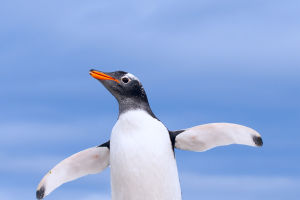Killer whales, also known as orcas, are the most significant members of the dolphin family.
They have a distinct conical head and a black-and-white body pattern, with black on their back and sides, white on their abdomen, and an oval area behind their eyes. These majestic creatures have a wide range and can be found in almost any ocean habitat, although they prefer polar waters.
As the "overlords" of the ocean, killer whales are at the top of the marine food chain, which means that they have few natural predators. They have a varied diet, including all kinds of fish, sharks, whales, seals, penguins, and even great white sharks. Due to their position at the top of the food chain, killer whales play a crucial role in maintaining the balance of their ecosystem.
Killer whales are highly social animals and have stable family structures that can last for several generations. Some families even have a matriarchal system where the oldest female leads and guides the group. Killer whales use sound to communicate, locate, detect, and coordinate actions.
They can make a variety of sounds, such as buzzing, whistling, screaming, and clucking. The vocalizations of killer whales have individual and group characteristics that can be used to identify and locate each other. Some scholars believe that killer whales may even have their own unique culture due to their complex communication and stable family structures.
Killer whales prefer to live in groups, and they often form small groups of 2-3 individuals or large groups of 40-50 individuals. They spend 2-3 hours a day quietly floating on the surface of the water, as their lungs are filled with enough air to allow them to do so safely.
Group members often keep in contact through their pectoral fins, showing affection and unity. If a member of the group is injured or loses consciousness, other members will come to help.
Killer whales are very agile animals and can swim underwater at speeds of up to 55 kilometers per hour.
They can also jump out of the water to perform difficult tricks, which is a behavior unique among marine mammals. Killer whales also like to slide and flip underwater, which is not only a habit of their life but also a way for them to exercise and communicate.
Orcas have a relatively low reproductive rate, with females typically giving birth to one calf at a time after a gestation period of about 15 months. The cubs are fed on their mother's milk after birth and leave their mother at about a year of age.
Despite being marine mammals under international protection, the survival of killer whales is still under threat due to human disturbance and environmental pollution.
To protect these beautiful creatures, measures need to be taken to reduce the impact of human activities on them and to strengthen regulation and conservation measures to ensure their survival and reproduction.
Killer whales are fascinating and majestic creatures with complex communication, social structures, and behaviors. They play a crucial role in maintaining the balance of their ecosystem and need our protection to ensure their survival for future generations.


